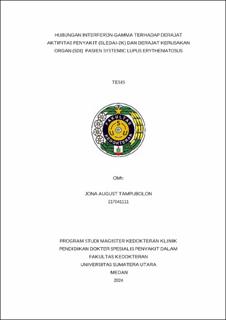| dc.description.abstract | Background: SLE is a chronic autoimmune disease that causes organ damage
and has diverse clinical symptoms. High morbidity and mortality are linked to
increased disease activity. The interferon signaling pathway is activated in SLE
cases, but its link to higher SLE disease activity remains unclear. This study aims
to investigate the role of IFN-gamma in influencing the activity level of organ
damage in SLE.
Methods: Following inclusion and exclusion criteria, this cross-sectional study
was conducted over 6 months at H. Adam Malik Hospital Medan. The data
collected included clinical manifestations, SLEDAI and SLICC Damage Index
(SDI), and IFN-gamma levels. The impact of IFN-gamma on the extent of organ
damage activity was assessed using a correlation test. Linearity and correlation
strength were considered statistically significant, as indicated by a p-value less
than 0.05.
Results: The study included 67 patients, mostly women (9:1 ratio), with an
average age of 35. Moderate disease activity was observed at 41.8%, the median
SDI organ damage score was 1, and the median IFN-gamma level was 31.16
pg/mL. The mean interferon-gamma levels exhibited a progressive increase
corresponding to the severity of disease activity. Specifically, the levels were
39.48 ±28.65 during remission, 93.49±105.5 with mild disease activity,
200.55±374 in moderate cases, and 208.84±336 in severe cases. IFN-gamma
showed no significant correlation with disease activity (SLEDAI) or the SLICC
Damage Index (SDI), with r values of +0.055 (p = 0.659) and +0.083 (p = 0.506).
Conclusion: Interferon-gamma levels do not correlate with disease severity or
organ damage in SLE patients.
Keywords: SLE, IFN-Gamma, SLEDAI, SLICC Damage Index | en_US |


